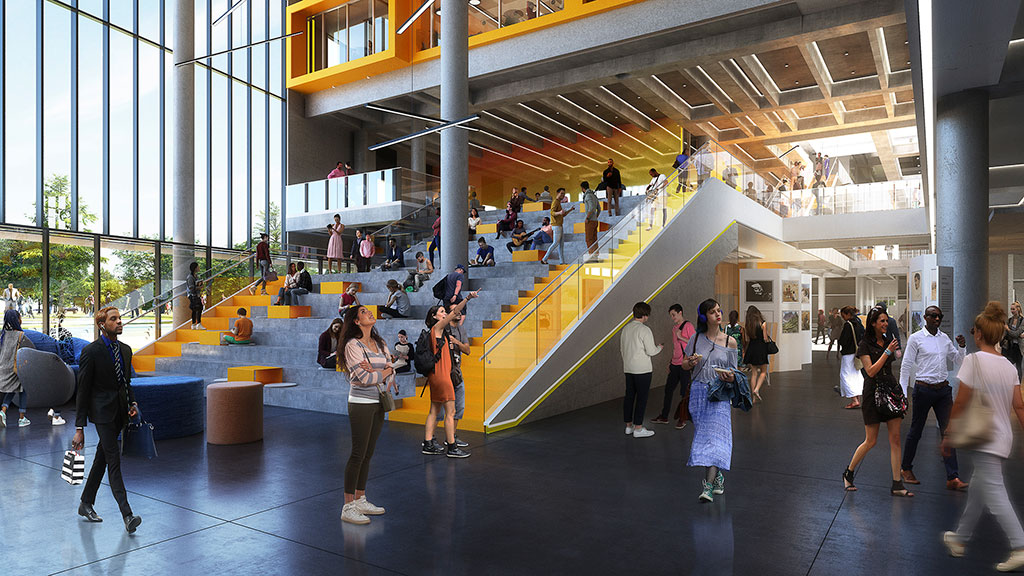To Foster an Engaged Student Body, Holistic Campus Design Is Key
June 22, 2023 | By Allison Marshall
Over the past few years, students have been offered an increasing number of choices for learning and working. As a result, the purpose of the physical campus is shifting. Declining enrollment and changes in student expectations are two of the biggest challenges higher education institutions face today, according to Wiley’s The State of the Student 2022. To address these concerns, we should approach higher education campus design with the goal of building an engaged community by creating dynamic social spaces and prioritizing well-being.
Creating Dynamic Social Spaces
The higher education experience must evolve to meet current conditions and demands. To attract and retain a strong student body, it’s vital to create dynamic social spaces throughout campus. These areas serve as a place for chance encounters, classroom break out spaces, group study areas, and club/organization meetings, and they also foster engagement. Engagement is a powerful leading indicator of student success in any course, with a high correlation between student engagement and overall student academic performance.
Gensler’s Education Engagement Index, an annual survey that captures a broad sample of students and educators across the U.S. to understand their current experience and how they feel about the future of learning, indicates that the main reasons students come to campus and stay on campus are for socializing and working with classmates. To support these critical engagement drivers, there is a need for social spaces outside of the traditional classroom.
At Tarrant County College in Fort Worth, Texas, the design team integrated amphitheater stairs that double as seating into the Administration Onboarding to welcome guests while encouraging a fluid connection to the surrounding area both visually and socially. This space becomes a dynamic hub for students to meet, study, take a break between classes, or even provide seating for a larger event.
Prioritizing Wellness Throughout Campus
As we seek to create spaces that support an engaged student body, it’s important to emphasize overall well-being. The Wiley report found that “supporting students through their financial, mental, and emotional struggles can also help institutions with multiple challenges, including enrollment, retention, and engagement levels.”
Recently, Gensler partnered with the University of Kansas to develop more than 170 Key Performance Indicators (KPIs) that measured the campus experience’s impact on student wellness. Using this measurable impact framework, we evaluated campus improvements through a wellness lens, considering factors such as water availability and quality, inclusive design and ergonomics, exposure to chemicals of concern in materials, lighting and access to daylight, heat islands, walkability and pedestrian/bike safety, and more. The KPIs were evaluated and prioritized to create an integrated strategy to address wellness campuswide.
Wiley reports that almost half of undergraduate students (49%) note declining mental and emotional health as a difficulty. This information presents a critical opportunity for designers to create an optimized campus environment that provides students with much needed access to spaces dedicated to addressing overall well-being.
An excellent example of a higher education institution that embraced a well-being focused design strategy is West Coast University Texas in Richardson. The design team prioritized well-being throughout the design process by creating an active learning ecosystem intended to easily shepherd students through a rigorous educational program. A variety of available spaces foster collaboration and engagement and are always activated with layered programming, ensuring a multitude of uses throughout the entire day and semester. For those seeking a more private experience, zones dedicated to focus and quiet work are incorporated. Biophilic design, which has been shown to improve cognitive function and enhance mood and creativity, is also integrated throughout the space.
Building an Engaged Community
Students need to feel supported both inside and outside of the classroom. As the expectations of students change and enrollment declines, building an engaged student body directly impacts the culture and community fostered in higher education settings. By understanding the needs of students and taking definitive action to incorporate dynamic social spaces on campus and visibly prioritize student well-being, moving from a culture of transactional experiences to a culture of holistic engagement, campuses can provide high-impact spaces for students to thrive.
For media inquiries, email .
